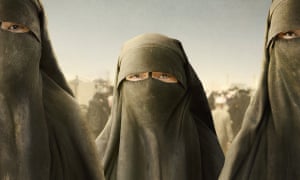A bride waving a flag in bombed-out Beirut: Christine Spengler’s best photograph
‘Shortly after arriving, I was kidnapped by a militia group who said I was a spy. A decade later, I went back to show life and beauty returning to the city’

I spent my childhood in Madrid and I went to the Prado every week from the age of seven. I would cry at the works by Goya. His paintings of the Spanish war of independence moved me like nothing else. I never grew up around photography – I grew up around Goya. Even as a child, I was attracted to the dark fates of the world.
Over the course of my career, I’ve covered 13 conflicts, more than many of the famous war photographers of my generation. I’ve worked in Vietnam and Cambodia, Eritrea and Northern Ireland, Afghanistan and Iran. I’ve always tried to capture a glimpse of hope against a background of drama and destruction. That has not always been possible.
I covered the Lebanese civil war between 1982 and 1984. Shortly after my arrival, I was kidnapped by Al-Mourabitoun, a militia group, who accused me of being an Israeli spy. They didn’t understand why I would be there otherwise, nor why I could speak Arabic. I was blindfolded, bound and transported out of Beirut. It was the first and only time in my entire career when something truly dangerous happened to me. It was a terrifying moment.
Even during the war, Beirut held its spirit. Old people would take their chairs outside and sit under the sky and smoke their hookahs. Men, as well as women, would wear flowers in their jacket pockets – little camellias that signified life. I asked my driver about it once. He explained that Lebanese people love beauty, and the flowers show that eventually this will end. “We are on the side of life,” he said.
This image wasn’t taken during the worst of the war years, though. Later, in 1994, I was assigned by Marie Claire to cover the reconstruction of Beirut and the return of life to the city. I loved being able to go back. After death, coffins, bombs and funerals, I was sent to photograph life and beauty.
In war or post-conflict zones, you often see surreal things. I saw soldiers adorned with flowers. I met a girl staging a fashion show in the city’s ruins. I distinctly remember one woman saying that she used to dance as the bombs fell. And then one day I stumbled upon this scene.
It was taken at the border of the two Beiruts. Like Belfast, the city had been carved up in the fighting. This woman was in a completely immaculate bridal dress, posing in the ruins, waving this huge national flag. In some ways it’s a strange image, but it is a scene I saw repeated across the Middle East – young people posing in the ruins of their country. To me, this is an exorcism, a declaration that the war is over, that life has begun again, and also way of marking the past as the past.
Shooting war is a sensitive thing. As a woman, you have to be a chameleon. I think in that respect being a woman was a strength. A man just wears a pair of jeans and a shirt. I could wear a turban in the deserts of the Sahara, a chador moving through Iran, or a burqa travelling through the Afghanistan of the Taliban.
But the reason I have succeeded is, I think, because of empathy. I lost my brother when he was only 23 while I was covering the Vietnam war. I think when women in Arabic countries saw me step out of my taxi, all in black, they sensed that I was a widow too, in my own way, because I had lost the person I loved most in the world.
Looking back over my career, my proudest moment isn’t a picture or an exhibition. It’s that I have never in my life made a picture without the agreement of the person. I have never robbed an image. The men, women and children I have photographed all look me in the eye. I have never stolen their souls.
Born: Vichy, France, 1945.
Trained: Self-taught.
Influences: Francisco Goya.
High point: “My retrospective at La Maison Européenne de la Photographie.”
Low point: “My ‘arrest’ in Beirut in 1982 by Al-Mourabitoun. I was supposed to be executed.”
Top tip: “Get a press card and travel to conflict zones with the help of NGOs.”
This article was amended on 4 August 2021. An earlier version incorrectly stated that Goya’s paintings were of the Spanish civil war.



